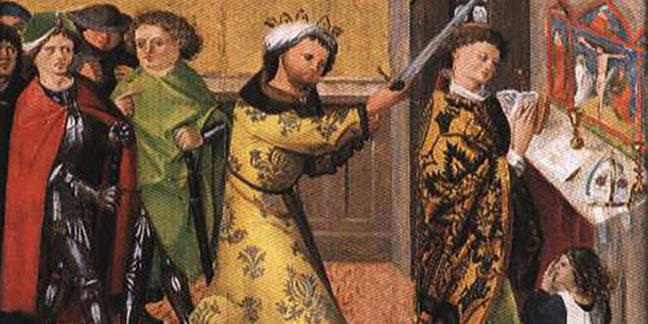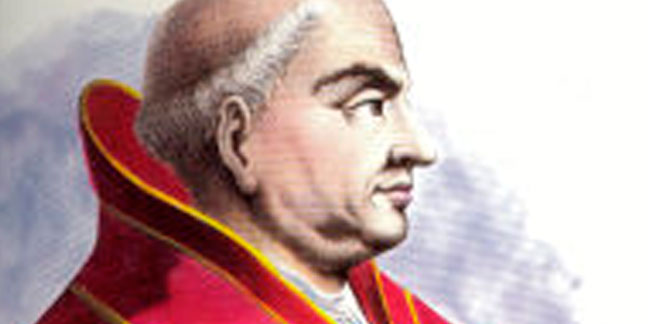 On April 11, the Catholic Church honors the memory of the 11th-century bishop and martyr St. Stanislaus of Krakow, who died for the faith at the hands of King Boleslaus II.
On April 11, the Catholic Church honors the memory of the 11th-century bishop and martyr St. Stanislaus of Krakow, who died for the faith at the hands of King Boleslaus II.
Canonized in 1253, St. Stanislaus is a beloved patron of Poland and one of the earliest native Polish bishops. In his own country he is commemorated on May 8. (The exact date of his death is uncertain. According to different sources, it was either April 11 or May 8, 1079.)
St. John Paul II – who was Kraków’s archbishop in the “See of St. Stanislaus” before becoming pope – paid tribute to him often during his pontificate. In a 2003 letter to the Polish Church, he recalled how St. Stanislaus “proclaimed faith in God to our ancestors and started in them...the saving power of the Passion and Resurrection of Jesus Christ.”
“He taught the moral order in the family based on sacramental marriage. He taught the moral order within the State, reminding even the king that in his actions he should keep in mind the unchanging Law of God.” Through St. Stanislaus, God taught the Polish pope’s homeland to respect “the Law of God and the just rights of every person.”
Born near Kraków in July of 1030, Stanislaus Szczepanowski was the son of Belislaus and Bogna. His parents, members of the nobility, showed great zeal and charity in their practice of the Catholic faith. Their son studied for a time in his own country, and went on to learn theology and canon law in Paris. The death of his parents left him with a large inheritance, which he gave away to the poor.
After his ordination to the priesthood, Stanislaus served the Church in Kraków in different pastoral and administrative posts. Following the death of the diocese’s leader, Bishop Lambert Zula, Stanislaus was chosen as his successor in 1071. He did not want the position, but obeyed Pope Alexander II’s direct order to accept it. Having done so, he proved to be a bold preacher of the Gospel.
This boldness brought him into conflict with Poland’s ruler, King Boleslaus II, who was becoming notorious for his violent and depraved lifestyle. After a series of disputes over his scandalous behavior and other matters, Stanislaus found no success in his efforts to reform the king.
He excommunicated the sovereign – who responded with furious anger, sending henchmen to kill the bishop while he was offering Mass in the Chapel of St. Michael, located in a suburb of Kraków. But the soldiers all came out, saying they had been frightened by a light from heaven. Boleslaus then took matters into his own hands, ambushing Stanislaus and striking him down with a sword at the altar.
St. Stanislaus was soon acclaimed as a martyr, while Boleslaus II was deposed and fled to Hungary. In later years the fallen monarch is said to have lived in a monastery, repenting of the murder.
— Catholic News Agency
 Pope St. Martin I died a martyr for defending the faith against the influences of imperial power and a popular heresy of the time.
Pope St. Martin I died a martyr for defending the faith against the influences of imperial power and a popular heresy of the time.
He was born in the Italian town of Todi and served as nuncio to Pope Theodore I in Constantinople. He was named successor to Theodore on July 5, 649 – without getting prior approval from the Roman emperor Constans II. This independent act so enraged the emperor that he refused to acknowledge Martin as the legitimate pope.
The emperor was further angered when Martin convened a synod at Lateran to combat the Eastern heresy of Monothelitism, which held that Jesus did not have a human will, only a divine will. Constans did not support Monothelitism per se, but he ordered that no one could discuss Jesus' will at all. The Lateran council affirmed that Jesus had two natures and two wills, human and divine. The council of 105 bishops also condemned the emperor's command to avoid discussion on the topic.
In the summer of 653, Constans ordered Martin to be kidnapped, arrested and brought to trial in Constantinople. The emperor's guards boldly entered the Lateran, arresting the bedridden Martin and tossing him on a ship for the three-month voyage to trial in Constantinople. When he arrived in Constantinople, Martin was sickly – racked with dysentery and disabled by gout. He was thrown into solitary confinement in a freezing and filthy cell.
On Dec. 19, 653, Martin was brought to trial on trumped-up charges of treason and sacrilege. The pope, near death and realizing his position futile, only laughed at the ridiculous accusations and begged the emperor to excuse the fumbling witnesses before they added perjury to false witness.
Constans pronounced a predetermined verdict of guilty on the pontiff and sentenced him to public flogging and execution. After the sentence was read, Martin was taken to a terrace of the palace near the imperial stables where crowds had gathered.
The puppet judge who had presided at the tribunal mocked Martin, saying, "You see how God delivered you into our hands. You were against the emperor, and thus has God abandoned you."
Then the soldiers slashed his clothing and took away his shoes. He was delivered to the prefect of the city with the order of execution. The judge tried to incite the populace to anathematize Martin, but the mob remained silently gazing at the ground. After a while, the crowd dispersed.
The soldiers stripped the pope of his shredded clothes and dressed him in a grotesque tunic, open on both sides, to humiliate him. They put an iron ring around his neck, with a rope attached to it, and dragged him back to prison. In the freezing cold, Martin trembled and awaited death.
It was only by the dying Patriarch Paul's intercession that Martin's sentence of public execution was commuted to banishment. He was exiled to Crimea, where he died Sept. 16, 655, suffering from cold and starvation.
Today Martin is venerated as a saint by both the Catholic and Orthodox Churches.
— Sources: "The Popes: A Papal History," by J.V. Bartlett, and www.catholicnewsagency.com

